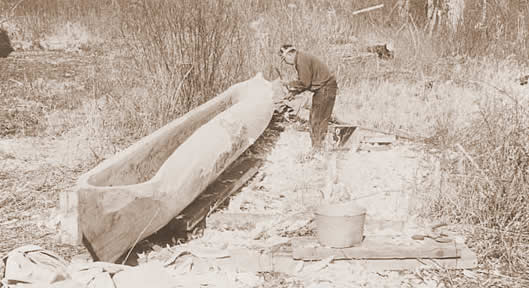
David Hotch in the process of making a cottonwood canoe in Klukwan, 1953-57.
Use of local timber resources began centuries ago with the natives of the region, the Tlingits. They burned wood for heat, stripped bark from cedar trees (lengthwise only, in order not to kill the tree) to supply weavers of the Chilkat blanket, made dugouts from local cottonwood trees and carved household implements and ritual paraphernalia out of wood. As non-native people began settling in the area the Tlingits instigated what was likely the first exchange of local forest products for cash as they supplied the new settlers with firewood. In the early 1880s Aurel Krause of the Bremen Geographical Society, Germany, recorded that the most common service provided by the natives for the new settlers is the cutting and hauling of wood. “For a cord, 8 by 4 by 4 feet of wood, cut and stacked, the price is two dollars.”
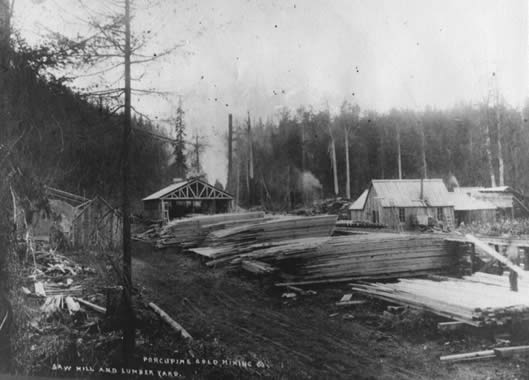
Porcupine Gold Mining Company sawmill and lumber yard, 1914.
When entrepreneur Jack Dalton had the area around the Porcupine gold field surveyed to build a town, he realized that for so large a project he would have to have an on-site sawmill, and proceeded to build one that could produce 5,000 board feet a day. He also produced lumber needed for the large flumes, the largest of which was a diversion flume constructed by the Porcupine Mining Company requiring between one and two million board feet. Demand for lumber continued in the mining district because seasonal floods frequently washed out the flumes.
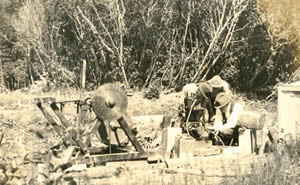
Small portable saw mills like this one were used by many people for the production of rough lumber, 1920s.
Ft. Seward and local canneries were built from lumber that was shipped by sail or steam vessels from Seattle, Olympia, or Portland. The lumber to build the Presbyterian Mission building in Klukwan was shipped to Haines and transported to the village by canoe—quite a prodigious task. A few small, private mills were operated by some of the canneries during their construction, and for fish traps. Piling for docks was contracted locally, and as these pilings were not treated, they needed to be replaced frequently.
A local mill operated by Combs Lumber Company had a capacity of 25,000 board feet in 1907. Local newspaper advertisements proclaimed it “the largest saw and planning mill on Lynn Canal.” This mill was destroyed by fire in 1912. Without a strong outside market, the timber industry remained small for many years, with firewood being its main product.
In 1939, the Schnabel family started the first really big lumber business in Haines. A sawmill was built and operated over many years at Jones Point. In 1961, this uninsured mill burned, almost wiping out the company and leaving many without work. Schnabel set to work using small portable mills. Railroad ties were marketed to a Whittier treatment plant, and later, cants (large timber, roughly sawed from logs, and intended for further processing into dimensional lumber) were cut for export to Japan. In 1966 Schnabel began construction of a new mill at Lutak Inlet just past today’s ferry terminal. Year round operation began in 1967. Spruce and hemlock cants were cut for export.
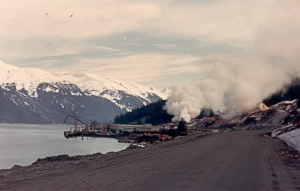
Schnabel Lumber Mill on Lutak Road just past the current ferry terminal, 1960s-1970s.
The Schnabel Lumber Company exported one million board feet of lumber in 1961. Exports reached a high of fifty-two million board feet in 1968. The company briefly operated a veneer mill, but that operation was not sustainable due to incompatibility with the cant mill. Slab waste, cull timber, and waste previously left in the forest were chipped and exported to Japanese markets. This mill closed in 1977.
In 1965 another sawmill was built at Jones point by Alaska Forest Products, Incorporated (AFP). AFP also cut cants for the expanding Japanese market. The monthly payroll of $50,000 (1967) had a significant impact on the local economy. Extremely favorable market conditions in the 60s and 70s were followed by years of market slumps, higher prices for raw logs, increased operating expenses, and transportation problems. The company entered the domestic dimensional lumber market for awhile, but finally closed in 1976.
In 1979, Schnabel Lumber Company reopened the Lutak Inlet facility and began upgrading it to comply with the Clean Air Act, specifically to complete a waste wood electrical generating plant. The State of Alaska loaned the company capital for the project. However, delays in obtaining logs forcing default on export contracts, coupled with double-digit inflation impacting completion of the electrical plant, spelled financial doom. The State of Alaska foreclosed on Schnabel Lumber in 1983. During its last period of operation, Schnabel Lumber Co. exported the first Alaskan lumber to China in addition to carrying on its Japanese and domestic trade. In 1984, Pacific Forest Products purchased the Schnabel facility. A poor market and other factors caused that company’s closure within a year’s time.
The newly formed Chilkoot Lumber Company negotiated with the state of Alaska for purchase of the former Pacific Forest Products facility in November 1986. The Company began total renovation in March 1987, and was under operation in November with approximately 55 local employees on the payroll. With 100% of its timber coming from the Tongass National Forest, Chilkoot Lumber processed spruce into cants, flitches, and dimensional lumber, and hemlock into 105mm squares, the primary building component in Japanese post and beam construction. The mill produced 35 million board feet annually.
For a few more years, despite ongoing problems and obstacles, the Chilkoot Lumber Company continued to operate and nearly double its capacity. The diesel generator blew in January of 1988, forcing the mill to rely solely on a refurbished steam power plant operated by Onsite Energy. Chilkoot Lumber was reported by owner Ed Lapeyri to be harvesting 60 million board feet a year in October of 1990. Difficult timber market conditions and expenses required to meet emissions standards put great pressure on the mill’s economic viability. Although the mill was reported in January of 1991 to finally meet state standards for clean air, market conditions forced temporary and later more permanent layoffs throughout 1991, impacting the Haines economy with loss of 145 local jobs and a payroll of $5.2 million. Klukwan Inc. and Northern Timber, two other locally based corporations also began scaling back logging operation around this time.
A February 1993 snowfall sealed the fate the mill, collapsing major structures and causing millions of dollars in damage. Destroyed were the planer mill, the main sawmill, the banding shed, and fuel sheds. The bank began parting out the mill property later that year. Although a jury awarded Chilkoot Lumber Company $1.22 million damages from Weyerhauser in 1994 following a lengthy court battle over previous grievances, it was not enough to resurrect the project.
The Southeast Alaska timber industry declined even more in the mid-1990s as ongoing state and federal studies indicated that allowable timber harvest was to be reduced on both state and federal lands in order to keep the industry at sustainable levels while better protecting wildlife and watershed values.
LeRoy “Buster” Benson, who started his private mill in 1976 to serve the local construction market with rough-sawn lumber, operated the primary local sawmill in Haines until his death in 2008. Buster gots his timber from State Forestry sales as well as from private landowners. He either purchases logs outright, or sawed half the lumber for free in exchange for the other half. Benson estimated that he produced approximately 250 thousand board feet of rough cut lumber for the local market annually. Several small, private, portable mills still operate in the Haines area. In addition, two lumber companies in Haines, Lutak Lumber and Haines Home Building Supply, offer imported finish lumber for local construction purposes.
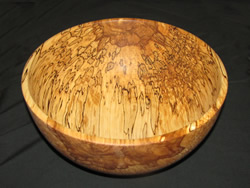 A beautiful birch bowl turned by local artist John Norton, 2013. |
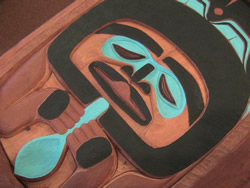 The bottom of a feast try carved by local mastercarver Jim Heaton, 2008. |
Many fine woodcraft artisans, both native and non-native, operate their business in Haines and use a variety of Alaskan wood and other woods to produce carvings, turned wood items, furniture, boats, cabinets and homes. Some of this wood is cut locally, some comes from elsewhere in Alaska, and some comes from other parts of the nation and the world.
Linda and Rick Shelton, 1978
updated by Barbara Waterbury (1988) Kathleen Menke (1997) and Blythe Carter, 2013
Bibliography:
Alaskan. Sitka, Alaska. 1885-1907.
Allen, P.B. (“Doc”), interview with Rick Shelton on September 24,2978 in Wenatchee, Washington.
Benson, LeRoy (“Buster”), interview with Kathleen Menke on December 23, 1996 in Haines, Alaska.
Chilkat Valley News front page stories, Jan. 14, 1988, Sept. 28, 1989, June 21, 1990, Oct. 19, 1990, Oct. 25, 1990. Apr. 30, 1992, Jan, 10, 1991, June 6, 1991, Oct. 10, 1991, Nov. 19, 1992, Feb. 11, 1993, Nov. 11, 1993, March 3, 1994, June 9, 1994, and Oct. 13, 1994.
Cooley, Richard A. “An Economic Study: Haines, Alaska.” Juneau: Alaska Development Board 1953.
DeArmond, Robert. “This Month in Northland History.” Alaska Sportsman. July 1968.
Engel, Gerry, interview with Barbara Waterbury on December 12, 1987 in Haines, Alaska.
“Haines—A coming Alaska Town,” Alaska Monthly Magazine, April 1907.
Haines Pioneer Press. May 1909 to July 1913.
Krause, Aurel, Erna Gunther, translator. The Tlingit Indians. University of Washington Press, Seattle. 1956.
LaBau, Vernon J. Timber Supply and Use in the Haines—Skagway Area, Alaska. Pacific Northwest Forest and Range Experiment Station, Portland. 1976.
Local artisans/craftsmen, Scott Carey, Guy Hoffman, John Hagen, Jim Heaton, Tim June, and Tresham Gregg in interviews by Kathleen Menke, 1996 in Haines, Alaska.
Pavitt, R.W. and Associates, Inc. Haines Comprehensive Plan. Juneau. 1976.
Report of the Governor of Alaska. U.S. Government Printing Office, Washington D.C. 1891-1912.
Saupe, Gary, interview with Rick and Linda Shelton on November 6, 1978 in Haines, Alaska.
Schnabel, John, interview with Barbara Waterbury on December 12, 1987 in Haines, Alaska.
